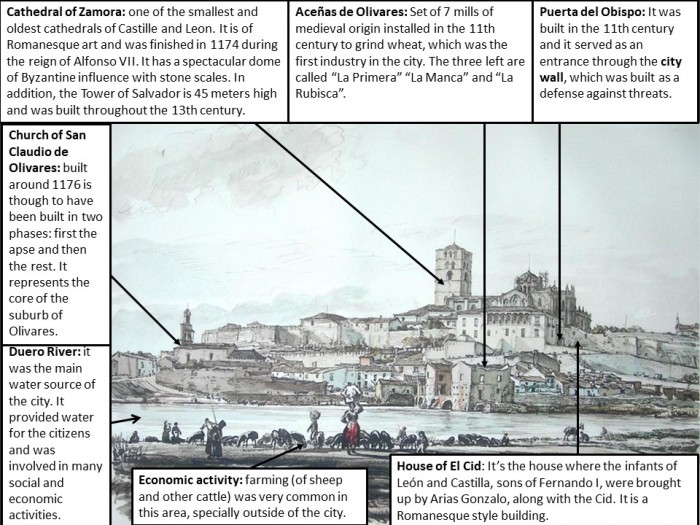This work of art portrays the city of Zamora from the opposite shore of the Douro River. It belongs to the book Old Spain, a portfolio written and illustrated by Muirhead and Gertrude Bone, a Scottish couple who travelled through Spain between 1925 and 1928. The book included images of Spanish streets, marketplaces and squares. The paintings were made in London in 1936, by Muirhead, after their journey. Thus, this engraving exhibits the city of Zamora and its activity in the 20th century. Nowadays, this painting belongs to a private collection.
In the image we can distinguish two areas, divided by the image of the Douro River, which served as a protection for the city but was also involved in many social and economic activities: in the foreground we can observe the development of some social activities such as women taking water from the river in jugs or people taking the cattle to drink. We can also see some economic activities, typical from Zamora at that time, such as the farming of sheep. In addition, although we cannot see much of the surroundings of the city, we can suppose it is a rural area with cropfields. This is because in the early 20th century, Zamora was still an agricultural production center based on the gathering of wheat and grapes, with no industry. Hence, not being the life of its citizens very different from the medieval times.
Furthermore, in the background we can observe the urban area, specifically the area of the Cathedral, which represents the origin of the city. Zamora rose on a strategic hill, defended to the south by the Douro River. The period between the 10th and 13th centuries is considered as the one with the greatest political and economic splendor of the city, which is the main reason to why Romanesque style buildings are so abundant in this area.
Moreover, as a medieval town, the urban layout of Zamora is irregular. Thus, the town pattern is nucleated, as houses are all clustered at the top of the hill and mostly inside the City Wall. This wall is also one main feature of the Medieval cities. It served as a protection for citizens against foreign invasions and other threats. In addition, the castle of Zamora was built in the 11th century. However, it differs a lot from the castles built at that time. It is a strong fortress instead of a palace, which was the custom at the time. It is said that the wall, as well as the castle, reflects perfectly the history of Zamora.
To conclude, Zamora was the setting for many historic significant events which has had a clear impact on the architecture of the city over the years. An enormous amount of battles and conquests between Muslims and Christians armies took place in Zamora between the 8th and 10th centuries. Besides, in the year 1067, Sancho II put a siege on Zamora that lasted more than seven months and the citizens resisted heroically, giving rise to the famous saying: «Zamora was not won in one hour».
Carmen Rasero Candelario

